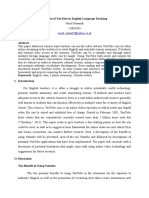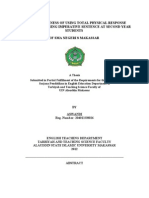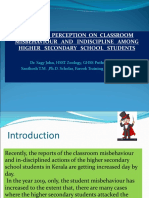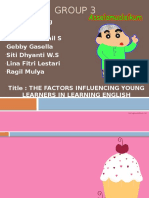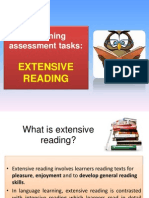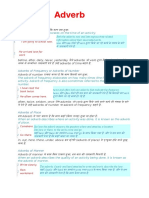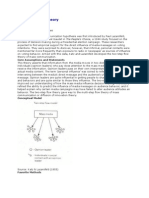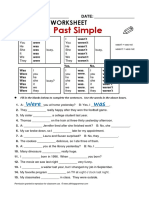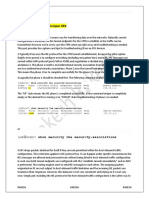Tefl Makalah
Tefl Makalah
Uploaded by
Inggrit SisiliaCopyright:
Available Formats
Tefl Makalah
Tefl Makalah
Uploaded by
Inggrit SisiliaOriginal Title
Copyright
Available Formats
Share this document
Did you find this document useful?
Is this content inappropriate?
Copyright:
Available Formats
Tefl Makalah
Tefl Makalah
Uploaded by
Inggrit SisiliaCopyright:
Available Formats
1
Teaching English as Foreign Language
Teaching and Assesing Speaking
Member of Group :
1.
2.
3.
4.
5.
Risyah Darsih
Nur Aini Yan Meinati
Bunga Navyani
Yunita Dwi Ariani
Lailatus Solikhatin
English Department
Faculty Teacher Training and Education
University of Muhammadiyah Malang
2014
1. Strategies of speaking fluently
A. Don't study grammar too much
Studying grammar will only slow you down and confuse you. You will think about the
rules when creating sentences instead of naturally saying a sentence like a native.
Remember that only a small fraction of English speakers know more than 20% of all the
grammar rules. Many ESL students know more grammar than native speakers. I can
confidently say this with experience. I am a native English speaker, majored in English
Literature, and have been teaching English for more than 10 years. However, many of my
students know more details about English grammar than I do. I can easily look up the
definition and apply it, but I don't know it off the top of my head.
B. Learn and study phrases
Many students learn vocabulary and try to put many words together to create a proper
sentence. It amazes me how many words some of my students know, but they cannot create
a proper sentence. The reason is because they didn't study phrases. When children learn a
language, they learn both words and phrases together. Likewise, you need to study and
learn phrases.
If you know 1000 words, you might not be able to say one correct sentence. But if you
know 1 phrase, you can make hundreds of correct sentences. If you know 100 phrases, you
will be surprised at how many correct sentences you will be able to say. Finally, when you
know only a 1000 phrases, you will be almost a fluent English speaker.
Don't translate
When you want to create an English sentence, do not translate the words from your Mother
tongue. The order of words is probably completely different and you will be both slow and
incorrect by doing this. Instead, learn phrases and sentences so you don't have to think
about the words you are saying. It should be automatic.
Another problem with translating is that you will be trying to incorporate grammar rules
that you have learned. Translating and thinking about the grammar to create English
sentences is incorrect and should be avoided.
C. Practice Speaking what you hear.
Reading, listening, and speaking are the most important aspects of any language. The same
is true for English. However, speaking is the only requirement to be fluent. It is normal for
babies and children to learn speaking first, become fluent, then start reading, then writing.
So the natural order is listening, speaking, reading, then writing.
The reason many people can read and listen is because that's all they practice. But in order
to speak English fluently, you need to practice speaking. Don't stop at the listening portion,
and when you study, don't just listen. Speak out loud the material you are listening to and
practice what you hear. Practice speaking out loud until your mouth and brain can do it
without any effort. By doing so, you will be able to speak English fluently.
D. Submerge yourself
Being able to speak a language is not related to how smart you are. Anyone can learn how
to speak any language. This is a proven fact by everyone in the world. Everyone can speak
at least one language. Whether you are intelligent, or lacking some brain power, you are
able to speak one language.
This was achieved by being around that language at all times. In your country, you hear and
speak your language constantly. You will notice that many people who are good English
speakers are the ones who studied in an English speaking school. They can speak English
not because they went to an English speaking school, but because they had an environment
where they can be around English speaking people constantly.
There are also some people who study abroad and learn very little. That is because they
went to an English speaking school, but found friends from their own country and didn't
practice English.
E. Study correct material
A common phrase that is incorrect is, "Practice makes perfect." This is far from the truth.
Practice only makes what you are practicing permanent. If you practice the incorrect
sentence, you will have perfected saying the sentence incorrectly. Therefore, it is important
that you study material that is commonly used by most people.
Another problem I see is that many students study the news. However, the language they
speak is more formal and the content they use is more political and not used in regular life.
It is important to understand what they are saying, but this is more of an advanced lesson
that should be studied after learning the fundamental basics of English.
2. Principles in teaching speaking
3. The role of teacher
As with any other type of classroom procedure, teachers need to play number of different
roles during the speaking activities described above. However, three have particular
relevance if we are trying to get students to speak fluently :
1. Prompter : students sometimes get lost, cannot think of what to say next, or in some
other way lose the fluency we expect of them.We can leave them to struggle out of such
situation on their own , and indeed sometimes this may be the best opinion . However ,
we may to help them and the activity to progress by offering discrete suggestions.
2. Participant : teachers should be good animators when asking students to produce
language. Sometimes this can be archieved by setting up an activity clearly and with
enthuasiasm . At other times , however teachers may want to participate in discussions or
role-plays themselves.That way they can prompt covertly , introduce new information to
help the activity along , ensure continuing student engagement , and generally maintain a
creative athmosphere.
3. Feedback Provider : the vexed question of when and how to give feedback in speaking
activities is answered by considering carefully the effect of possible different approach.
When student in the middle of a speaking activity , over-correction may inhibit them and
take communicativeness out of the activity . On the other hand , helpful and gentle
correction may get students out of difficult misunderstandings and hestination .
everything depend your tact and the appropriacy of the feedback we give in particular
situation.
4. Speaking Learning Techniques / classroom speaking activities
Talking is the primary means for fostering mutual understanding, mutual communication,
using language as a medium. Speaking activities in language classes have aspect of two
way communication, between the speaker and listener or a reciprocal basis. Thus training
should first talk based on : (1) the ability to listen, (2) the ability to say, and (3) mastery
(relative) vocabulary.
In general, the purpose of the exercise speaks for beginner and intermediate level is for
students to communicate orally in simple English. Therefore, the learning must be able to
inspire and motivate students to speak and have the courage to put it into practice. There
are nine techniques for speaking learning :
1. Ask and Answer .
Students are asked to do a question and answer . The process , have students record
some interview questions that need to be memorized . Then release the student asked
a friend in the class . Adjust the questions to the theme . Suppose theme Identitiy
Personal , Shopping List , Map and others. To check whether the students perform the
task , ask them to make a record that must be reported to the teacher after the learning
process ends . Teachers monitor students only and allow time for students to do a
question and answer .
2. Describe and Draw .
Students are paired . A student has a picture of the unknown by student B , and vice
versa . A student describes a picture that he have and draw appropriate student
information student B A. After a student finishes , replace student B explains
pictures . Have them compare the picture and gives the value of their liking .
3. Discussion
Decide on a topic and ask students in groups to discuss the topic of the corresponding
image . The technique is suitable to be applied for intermediate and advanced learners
.
4. Guessing .
Teacher or some students have an information that must be guessed by students or
other groups to ask in English .
5. Rememberring.
Students close their eyes and remember the example images of objects in the
classroom or the location of place .The technique is effective for sharpening memory
and minimize forgetting the vocabulary .
6. Miming .
A student practicing certain expressions such as feelings, do an activity, and others .
While other students to guess .
7. Ordering .
Students are asked to sort something by asking where is it to find a suitable place .
8. Completing a form / questionnaire .
Students are asked answered , or provide specific information to complete a form or
quiz . This technique effectively applied to identity-related subjects , such as
employment forms, passports and other filling .
9. Picture-based activities
Picture-based activities can be as simple as having students describe what they see in
pictures. That will help lower-level students develop speaking accuracy skills. Or you can
use pictures for discussions with intermediate and advanced students to help build their
speaking fluency. Picture-based activities can be used with all levels of classes. You just
need to adjust the nature of the activity according to your students level.
10. Role-play
Role-plays are like dialog performances, but there is no predetermined script. You assign
students roles and a situation and they act accordingly using language they have learned
previously. It helps to review the words and phrases they might need in the role-play
before they start. Role-playing is a good way for students to practice using spoken
language. It is helpful for all levels of students and develops both accuracy and fluency.
11. Rehearsed presentations
To build your students speaking accuracy and fluency, you may assign them to give short
speeches on various topics. They should have a chance to think, research, plan, and
rehearse their speeches. Rehearsed presentations are usually most successful when
students are at intermediate and higher levels because they usually require stronger
speaking skills.
12. Communication Games
Games which are designed to provoke communication between student frequently depend
on an information gap , so that student has to talk to a partner in order to solve a puzzle ,
picture or find similarities and differences between picture .
Taboo
Before class, create several index cards. On each card write one word in a large font with
a circle around it, and underneath write 2-4 related words in a smaller font. The goal is
for students to get their teammates to guess the circled word. They can say anything they
like to try to make them guess, except for the words written on the card.Divide the class
into groups of two, and write each group on the board to keep track of points. Place a
desk in the front of the room facing the class, so that someone sitting it has their back to
the board and can't read it. Place another desk in front of it, so the teammates are facing
eachother.Pick a team to go first, and have them choose a card. Have the teammates
decide who will guess and who will talk. The guesser sits with their back to the board. On
the board, making sure the guesser can't see, write the circled word as well as the other
taboo words. The talker then has to try to make their partner guess the circled word
without saying it, or any of the other words. After they guess it have another group come
up. When all the groups have gone, do it again and have the teammates switch roles.
Twenty Questions
First one member of the class chooses an object, an occupation, or an action which ever
you decide. Then members of the class try to discover what it is by asking questions
which can be answered by "yes" or "no."
For example, if the subject is "occupations" then the questions might be like these.
Do you work in the evenings?
Do you work alone?
Do you work outside?
5. Problems and solution in teaching Speaking
Common Speaking Problem
1. Student inhibition
Speaking activities require a student to have all eyes on him and exposure to an audience
can often give students stage fright. They may also be worried about making mistakes,
being criticized or losing face in front of the rest of the class.
2. Nothing to say
Another common problem is that students sometimes think they have nothing to say on a
particular topic. In reality, they may be bored or feel that the topic is unrelated to
anything they know. If this is the case, they will have no motivation to speak other than
the fact that they know they should be participating in the speaking activity. Students
often lack confidence in their speaking ability and feel they have insufficient language
skills to express exactly what they want to say.
3. The low of participation
There will always be dominant students in an English class making it difficult for more
reserved students to express themselves freely. Dominant students who interrupt
frequently or who constantly look for the teacher's attention tend to create an
environment in the ESL class where more timid students are quite happy to sit back and
watch the lesson unfolding instead of participating.
4. Mother-tongue use
Students who insist on using their mother tongue are students who are fearful of criticism
and need to be encouraged to speak English. Students must understand that they cannot
revert to their mother tongue as this will take away precious speaking practice time
during lessons and slow down oral progress.
Solutions of Speaking Activity Problems
Teaching English as a second language means being able to solve problems students may have in
acquiring certain language skills. There are a number of resources and activities available to get
round these common speaking problems:
a. Group work:
Group work increases the amount of time available for oral practice and allows more than one
student to benefit from speaking time. Working in groups also lowers the inhibitions of shy
students who are not comfortable speaking in front of the whole class.
b. Easy language:
Simple language makes it easier for students to speak for longer without hesitation and gives
them a sense of accomplishment. Essential vocabulary can be pre-taught or reviewed before the
activity enabling students to fill-out their speech with more interesting sentences and rich
language.
c. Interesting topic:
Choosing a topic according to the interests of the class ensures student motivation. If the material
and task instructions are presented clearly and enthusiastically students will be more likely to
meet the challenge set for them.
d. Clear guidelines:
Stating clearly what is expected from each student is essential in ensuring that everyone in the
group contributes towards the discussion. Appointing a chairperson to each group to regulate
participation is a way to make sure that dominant students leave discussion opportunities open to
more reserved students. Feedback reveals the results of thediscussion and motivates each student
to follow the guidelines.
e. English monitors:
A monitor can be appointed to each group to remind students speaking their mother tongue to
switch back to English. A lack of classroom management and discipline will encourage students,
who do not feel that there is resistance to their mother tongue, to easily revert back to it as soon
as they have problems expressing themselves.
You might also like
- English For Science and Technology - Learner S Approach PDFDocument10 pagesEnglish For Science and Technology - Learner S Approach PDFŽana Knežević100% (2)
- The Use of YouTube in English Language TeachingDocument7 pagesThe Use of YouTube in English Language TeachingNurul Hasanah BeautyShawol100% (1)
- Essay Negative Effects of Social MediaDocument3 pagesEssay Negative Effects of Social MediaJainamNo ratings yet
- We Do Need MethodDocument5 pagesWe Do Need MethodVeronica VeroNo ratings yet
- Syllabus English For Midwifery 2: Course DescriptionDocument2 pagesSyllabus English For Midwifery 2: Course DescriptionBobby PutrawanNo ratings yet
- Lesson Plan - NEW INTERCHANGE BOOK 2 LESSON 5Document6 pagesLesson Plan - NEW INTERCHANGE BOOK 2 LESSON 5Viviane Pires100% (1)
- Analisis Kesulitan Belajar Bahasa Inggris MahasiswaDocument14 pagesAnalisis Kesulitan Belajar Bahasa Inggris MahasiswaM Anugrah PradanaNo ratings yet
- Canoy - Goals, Content and SequencingDocument6 pagesCanoy - Goals, Content and SequencingFe CanoyNo ratings yet
- ProposalDocument48 pagesProposalEvi Evadi0% (1)
- Teaching Listening To Young LearnersDocument16 pagesTeaching Listening To Young LearnersFiky AriniNo ratings yet
- Writing Skills and Academic GenresDocument5 pagesWriting Skills and Academic GenresdeanylahNo ratings yet
- Functional Grammar: Naskah SoalDocument6 pagesFunctional Grammar: Naskah SoalNatanaelNo ratings yet
- Soal UTS ESP 2020Document2 pagesSoal UTS ESP 2020Pou PouNo ratings yet
- Lesson Plan Listening For Descriptive TextDocument4 pagesLesson Plan Listening For Descriptive TextEyelash MikhaNo ratings yet
- Chapter I Makalah Seminar On ELTDocument4 pagesChapter I Makalah Seminar On ELTkartikaNo ratings yet
- Skripsi Bahasa Inggris Improving ReadingDocument42 pagesSkripsi Bahasa Inggris Improving ReadingNanangSusanto86% (7)
- Assessing Listening Through Multiple Choice TestsDocument5 pagesAssessing Listening Through Multiple Choice TestsSriary PrawiniNo ratings yet
- Discourse Analysis MakalahDocument7 pagesDiscourse Analysis Makalahamhar-edsa-39280% (1)
- Chapter - 4 Teaching by PrinciplesDocument18 pagesChapter - 4 Teaching by PrinciplesSilvana SilvaNo ratings yet
- The Collection of Language Assessment IndicatorsDocument16 pagesThe Collection of Language Assessment IndicatorsEgie SuhendarNo ratings yet
- Challenges For Methods of Teaching English Vocabulary To Non-Native StudentsDocument20 pagesChallenges For Methods of Teaching English Vocabulary To Non-Native StudentsChưa Đặt Tên100% (1)
- Popular Methodology (TEFL Methodology)Document18 pagesPopular Methodology (TEFL Methodology)FedrataNo ratings yet
- ESPDocument6 pagesESPFhifi NovitasariNo ratings yet
- of ESP For Secretary Students On SMK 7 BatamDocument13 pagesof ESP For Secretary Students On SMK 7 BatamWulandari KristantiNo ratings yet
- Teaching Vocabulary Six Basic PrinciplesDocument3 pagesTeaching Vocabulary Six Basic PrinciplesmahmoudabusamraNo ratings yet
- Self Introduction & Introducing Other PeopleDocument12 pagesSelf Introduction & Introducing Other PeopleJanssen Samuel HalimNo ratings yet
- Improving Students Speaking Skills Through English SongDocument8 pagesImproving Students Speaking Skills Through English SongnindyaarrrNo ratings yet
- Eating Out - Exercises 4 PDFDocument2 pagesEating Out - Exercises 4 PDFpepe martinezNo ratings yet
- 209 Long Vowels Diphthongs and TripthongsDocument9 pages209 Long Vowels Diphthongs and TripthongsEristiana Sri AgustinNo ratings yet
- Coursebook AnalysisDocument41 pagesCoursebook AnalysisKarina Wahyu N100% (1)
- RPS Intermediate English GrammarDocument7 pagesRPS Intermediate English Grammaramy krisdiana fkipNo ratings yet
- Text, Genre, and Discourse Shifts NEWDocument55 pagesText, Genre, and Discourse Shifts NEWOuafaeNo ratings yet
- A Blended Learning Environment For Individualized English Listening and Speaking Integrating Critical Thinking 2013 Compu 1Document21 pagesA Blended Learning Environment For Individualized English Listening and Speaking Integrating Critical Thinking 2013 Compu 1Ketrin ViollitaNo ratings yet
- Community Language LearningDocument8 pagesCommunity Language LearningShinta Ari HerdianaNo ratings yet
- Suci Maharani 96 102 PDFDocument7 pagesSuci Maharani 96 102 PDFMohammad Matte UllahNo ratings yet
- Makalah Kel.5 ESPDocument17 pagesMakalah Kel.5 ESPOzieNo ratings yet
- Improving The StudentsDocument13 pagesImproving The StudentsameliaNo ratings yet
- Skripsi The Influence of The Ability in Mastering Dialogue On The Achievement in Learning English To The Second Year Students at M A N MagelangDocument32 pagesSkripsi The Influence of The Ability in Mastering Dialogue On The Achievement in Learning English To The Second Year Students at M A N MagelangTri Macoalo50% (2)
- Chapter II Audio LingualDocument19 pagesChapter II Audio LingualdwiNo ratings yet
- HUTECH ADVANCED TM Session 2Document17 pagesHUTECH ADVANCED TM Session 2Dương HiểnNo ratings yet
- PPT-student MisbehaviourDocument14 pagesPPT-student Misbehavioursagyjohn100% (1)
- Car-Chapter 1 EllynaDocument22 pagesCar-Chapter 1 Ellynaellyna_elvindoNo ratings yet
- GREETING AND PARTING Kelas 7Document7 pagesGREETING AND PARTING Kelas 7Neri Andik SetiawanNo ratings yet
- EN An Analysis On Students Speaking Skill ADocument8 pagesEN An Analysis On Students Speaking Skill AMira NurisantikaNo ratings yet
- Definition of VocabularyDocument3 pagesDefinition of Vocabularyrini oktiyaniNo ratings yet
- The Factors in EYLDocument6 pagesThe Factors in EYLMuthiaTanjung100% (1)
- Children and Adults in Second-Language LearningDocument9 pagesChildren and Adults in Second-Language LearningVictor BirknerNo ratings yet
- Fadhilah Nur Rohmah - Fitk PDFDocument115 pagesFadhilah Nur Rohmah - Fitk PDFavitaNo ratings yet
- Authentic MaterialDocument2 pagesAuthentic MaterialAna MartinezNo ratings yet
- Document Review Iwcp1Document20 pagesDocument Review Iwcp1r4nd4 4UNo ratings yet
- RPS Literal ReadingDocument13 pagesRPS Literal ReadingFransiska Densiana LurukNo ratings yet
- Makalsh CMDDocument22 pagesMakalsh CMDMaudy Rahmi HasniawatiNo ratings yet
- Mid Term Test Elt CurriculumDocument5 pagesMid Term Test Elt CurriculumMelaniAjaNo ratings yet
- Bab 2 SkripsiDocument21 pagesBab 2 Skripsiarsyil dwi anugrahNo ratings yet
- Assessing ListeningDocument6 pagesAssessing ListeninglistasinagaNo ratings yet
- Curriculum and Material Development RPS, Curriculum & Madev 21-22Document8 pagesCurriculum and Material Development RPS, Curriculum & Madev 21-22estu kaniraNo ratings yet
- Learner Errors and Error Analysis WENIDocument3 pagesLearner Errors and Error Analysis WENIWeni RatnasariNo ratings yet
- Silabus - ESPDocument6 pagesSilabus - ESPAdimarta TeguhNo ratings yet
- Designing Assessment Tasks - Extensive Reading 2Document9 pagesDesigning Assessment Tasks - Extensive Reading 2Farah NadiaNo ratings yet
- A Practical Experience of Institutional Textbook WritingDocument15 pagesA Practical Experience of Institutional Textbook WritingJustiniano Lhyn ViancaNo ratings yet
- 01b - Celta QuestionnaireDocument2 pages01b - Celta QuestionnaireDavid Douglas NegreirosNo ratings yet
- Computer, Internet, Web, and E-Mail Basics: Computer Concepts 8th Edition Parsons/OjaDocument76 pagesComputer, Internet, Web, and E-Mail Basics: Computer Concepts 8th Edition Parsons/OjaRafael Leonardo Guzman RodriguezNo ratings yet
- The HelpDocument64 pagesThe HelpGeorgina Rincón MuñozNo ratings yet
- TTT A1 TGDocument83 pagesTTT A1 TGsusom_iuliaNo ratings yet
- ArticleInclusivecommunication EdwinHoffmanDocument6 pagesArticleInclusivecommunication EdwinHoffmanTesa RafkhaniNo ratings yet
- Dichotomous Key Lesson PlanDocument3 pagesDichotomous Key Lesson Planapi-241043893No ratings yet
- 5G Vs WiFi 6Document14 pages5G Vs WiFi 6Bala JE/BSNLNo ratings yet
- Alix Bryan-Campos CVDocument4 pagesAlix Bryan-Campos CVAlix BryanNo ratings yet
- Yeastar TA410&TA810 User Manual enDocument55 pagesYeastar TA410&TA810 User Manual enNestor Daniel MorniroliNo ratings yet
- Yule Pragmatics NotesDocument16 pagesYule Pragmatics Notesrainbird_cz100% (1)
- Call EssayDocument7 pagesCall Essayapi-342980852No ratings yet
- Drama Techniques Help in Teaching GrammarDocument12 pagesDrama Techniques Help in Teaching GrammarFaris AfiqNo ratings yet
- Unit 3: Helping Your Students To Speak EnglishDocument31 pagesUnit 3: Helping Your Students To Speak EnglishmeniNo ratings yet
- Language Preservation: Questioning Linguistic Theory and PracticeDocument10 pagesLanguage Preservation: Questioning Linguistic Theory and PracticeShaneBrianDorolNo ratings yet
- Social Marketing PositioningDocument15 pagesSocial Marketing PositioningShubham BajajNo ratings yet
- Types of Adverbs With Hindi TranslationDocument10 pagesTypes of Adverbs With Hindi TranslationRahul ChoudharyNo ratings yet
- IP SpoofingDocument1 pageIP SpoofingKushagra AgarwalNo ratings yet
- CH 10Document8 pagesCH 10C.P. WongNo ratings yet
- Lecture 9-SOCIAL MEDIA MARKETINGDocument26 pagesLecture 9-SOCIAL MEDIA MARKETINGMaithili JoshiNo ratings yet
- Lazarsfeld TheoryDocument9 pagesLazarsfeld Theoryaishasayyad100% (3)
- Double Bubble Map (English)Document1 pageDouble Bubble Map (English)Virgilio CusNo ratings yet
- Atg Worksheet Beverbpast2 PDFDocument2 pagesAtg Worksheet Beverbpast2 PDFDianaDumaNo ratings yet
- The Nokia WayDocument2 pagesThe Nokia WayHiralal SenapatiNo ratings yet
- Valencia Reginald G Performance Task 4 Social Agents and How They Impact UsDocument4 pagesValencia Reginald G Performance Task 4 Social Agents and How They Impact UsReginald ValenciaNo ratings yet
- TUTORIAL LETTER - B - 001 - 2021 - 3 - BDocument6 pagesTUTORIAL LETTER - B - 001 - 2021 - 3 - BNOCNo ratings yet
- TL-WR940N Installation GuideDocument2 pagesTL-WR940N Installation GuideLuis Silva LacerdaNo ratings yet
- Lesson Plan PLCDocument3 pagesLesson Plan PLCapi-456995798No ratings yet
- IGNITE - Troubleshooting Juniper IPSEC VPNDocument5 pagesIGNITE - Troubleshooting Juniper IPSEC VPNvoucher01 jnciaNo ratings yet
- SAP TablesDocument6 pagesSAP Tableshema_hpbloreNo ratings yet
- Self-Assessment: Teacher Education St. Paul University PhilippinesDocument22 pagesSelf-Assessment: Teacher Education St. Paul University PhilippinesRodeza Umeran MaqueraNo ratings yet

